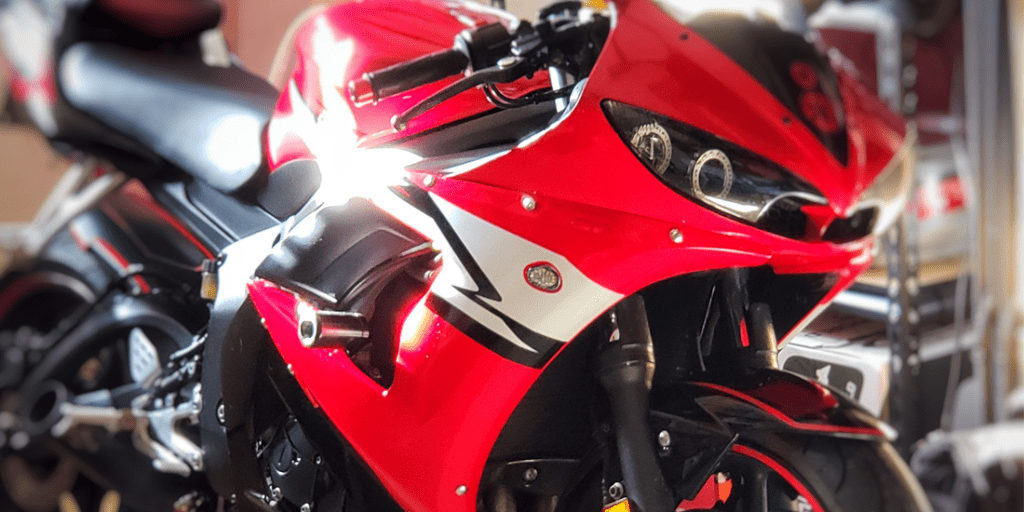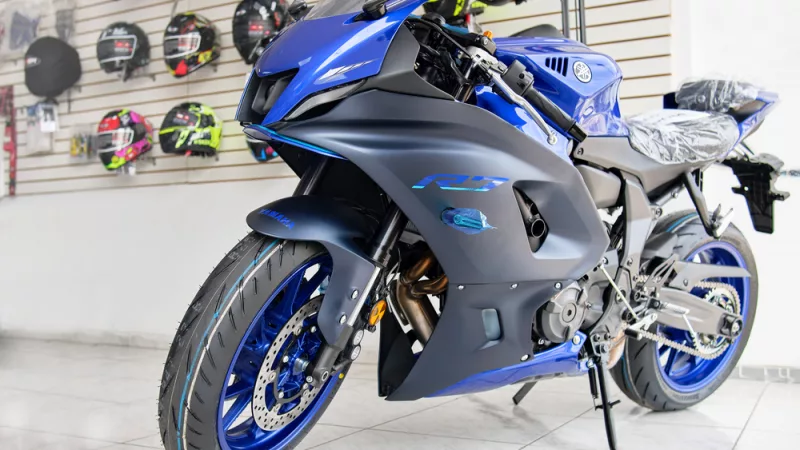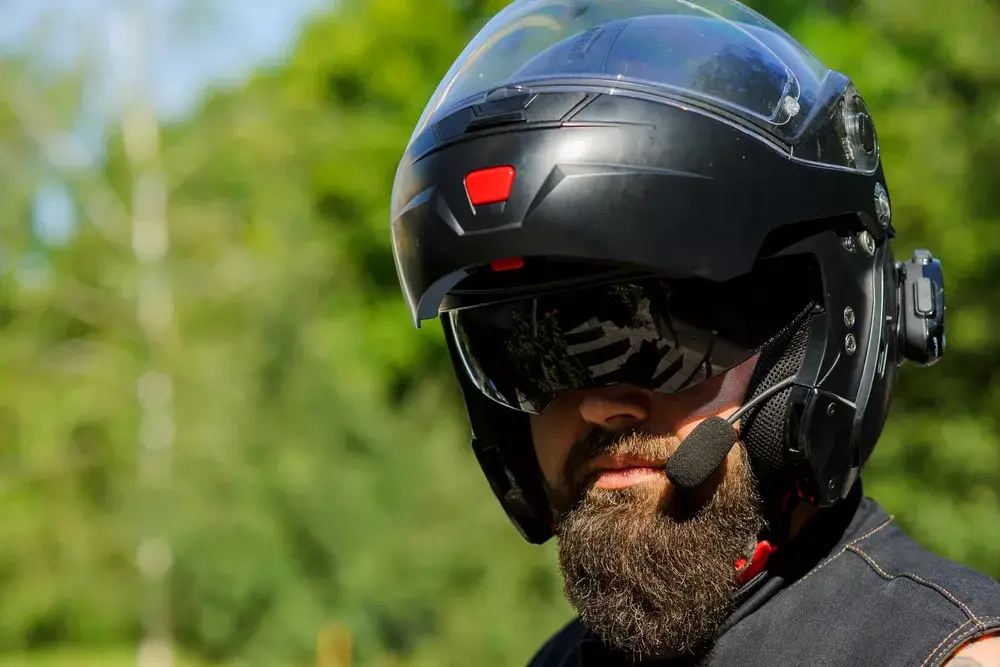Starting a motorcycle is easier than it used to be, thanks to technology. While there are various kinds of bikes, starting a Yamaha R6 or other fuel-injected motorcycles is more or less then same across the board.
Here is how you start a fuel-injected motorcycle, like the Yamaha R6:

Starting The Engine of a Yamaha R6
You can find this information in the owner’s manual of your bike, too. Before starting the bike, make sure you have done the following:
- The transmission is in neutral.
- The transmission is in gear, the clutch is pulled, and the kickstand/sidestand is stowed. Some modern models, Yamaha included, have a safety feature that will prevent the bike from starting if the sidestand hasn’t been raised.
Next, follow these steps precisely:
- Insert the key into the ignition.
- Turn the key to the ON position. Make sure the engine stop switch is set to the correct position.
- Warning lights and indicator lights should illuminate momentarily then disappear if conditions are satisfactory. These lights include:
- Oil level
- Coolant temperature
- Fuel level
- Shift timing
- Engine problems
- Immobilizer system
- Shift the transmission into neutral. The light should come on. If not, you might have an electrical circuit problem.
- Start the engine with the start switch.
- In the event of failure, wait a few seconds and try another start. Don’t draw out the time trying to start the engine to preserve battery power. Do not extend for more than 10 seconds.
General Instructions for a Fuel-Injected Motorcycle
Here’s some instructions to follow if you don’t have the make/model mentioned above:
How To Start A Motorcycle
- Put the motorcycle in neutral. Neutral is always located between 1st and 2nd gear.
- Put the key in the ignition if necessary.
* Note: Fuel-injected motorcycles have an engine management system. This means you don’t have to worry about using the choke lever. Only a small amount of throttle will be needed, regardless of engine temperature. - Start pulling the clutch near the left handlebar. Some riders choose to pull the clutch and front brake simultaneously, but the choice is yours.
- Press and hold the start button. You will find this on the right handlebar. Maintain your hold on the clutch.
- The motorcycle should automatically catch and start.
- If the engine doesn’t turn over and start immediately, you can try using the throttle while pressing the start button. Make sure you are holding the clutch.
- Remember to never crank the engine for more than 10 seconds clips at a time. Otherwise, you’re wasting battery power.
- You can slowly start to release the clutch.
Now, you’re ready to ride!

Final Thoughts
Unlike carburetor motors, fuel injection systems rarely fail. To prevent the pump from failing, do some routine maintenance. Get into the habit of listening to the bike and know what a healthy running engine sounds like. That way, if something unusual happens, you will be able to tell whether or not something is wrong with the pump fuse by sound alone.
Modern fuel-injected motorcycles are easy to start. Follow the instructions in this article, and you will have no problem.
For more information about how to start, ride, and care for your motorcycle, check out my YouTube channel. Hit the subscribe button for notifications whenever there’s an update.
You Might also like
-
Why an Adjustable Motorcycle Kickstand is a Game-Changer for Riders
Motorcycles are more than just vehicles; they’re a passion, a lifestyle, and for many, an expression of personal freedom. However, every rider knows that the smallest details can make the biggest difference when it comes to convenience, safety, and enjoyment on the road. One such detail, often overlooked, is the motorcycle kickstand. Specifically, an adjustable motorcycle kickstand can transform your riding experience in ways you might not have considered. Let’s explore why upgrading to an adjustable kickstand for your motorcycle could be a game-changer.
Key Takeaways
- Adjustable Kickstands Enhance Stability: They can be modified for various terrains, ensuring your bike stays upright in different parking conditions.
- Ideal for Customized Bikes: Modifications that alter a bike’s height and balance make adjustable kickstands a necessity for maintaining stability.
- Improves Ergonomics: Adjustable kickstands can be tailored to individual rider needs, making it easier to handle the bike, especially for those with physical limitations.
- Complementary Accessories: Kickstand pads and plates further stabilize the motorcycle, especially on soft or uneven surfaces.
Comparison Table: Standard vs. Adjustable Motorcycle Kickstands
Feature Standard Kickstand Adjustable Kickstand Stability on Varied Terrain Limited Excellent Customization Not applicable High Ergonomics Standard Adjustable for ease Compatibility with Mods Low High Cost Generally lower Higher initial, but cost-effective long-term Enhanced Stability on Varied Terrain
The primary function of a kickstand is to provide stability when the motorcycle is parked. Standard, non-adjustable kickstands are designed with a one-size-fits-all approach, assuming a level parking surface. In reality, riders face a variety of parking surfaces—gravel, grass, slopes, and uneven roads. An adjustable kickstand allows for length modifications, ensuring your bike remains upright and stable, regardless of ground conditions. This adaptability is not just about convenience; it’s a safety feature that prevents your motorcycle from tipping over and sustaining damage.
Customization for Custom and Modified Bikes
Customization is at the heart of motorcycle culture. Riders spend considerable time and resources modifying their bikes to reflect their personal style and to improve performance. These modifications can alter the bike’s original balance and height, making the original kickstand less effective or even unusable. Custom kickstands for motorcycles offer a solution, but an adjustable kickstand provides a versatile and often more economical alternative, accommodating changes in bike height and balance without the need for multiple replacements.
Improved Ergonomics and Accessibility
For shorter riders or those with limited physical strength, maneuvering a motorcycle on its kickstand can sometimes be challenging. An adjustable kickstand can be set to a height that reduces the effort required to lift the bike off the stand. This improved ergonomics makes riding more accessible and enjoyable for everyone, ensuring that the focus remains on the joy of the ride, not the struggle of parking.
Motorcycle Kickstand Pads and Plates: The Perfect Companions
While an adjustable kickstand offers improved stability and customization, pairing it with a motorcycle kickstand pad or plate can enhance its functionality even further. Kickstand pads distribute the motorcycle’s weight over a larger area, making them ideal for soft ground where a stand might otherwise sink. Similarly, motorcycle kickstand plates offer a stable platform on uneven surfaces, preventing the stand from slipping. Together, these accessories complement the adjustable kickstand, providing a comprehensive solution to parking challenges.
FAQs: Adjustable Motorcycle Kickstands
-
What makes an adjustable kickstand better than a standard one?
- An adjustable kickstand can be altered in length to suit various terrains and bike modifications, offering superior stability and customization.
-
Can I install an adjustable kickstand on any motorcycle?
- Yes, most adjustable kickstands are designed to fit a wide range of motorcycles, but it’s essential to check compatibility with your specific model.
-
Will an adjustable kickstand affect my bike’s balance?
- It will improve balance by allowing adjustments to accommodate different ground levels and modifications that may affect your bike’s original balance.
-
How do I know if my adjustable kickstand is at the right height?
- The bike should sit at a stable angle without leaning too much to one side. Adjust the kickstand until you find a stable and secure position.
-
Are kickstand pads and plates necessary?
- While not strictly necessary, they are highly recommended for additional stability, especially on soft or uneven surfaces.
-
Can adjusting my kickstand void my motorcycle’s warranty?
- Generally, no. However, it’s best to consult your warranty terms or manufacturer to be sure.
Conclusion: A Simple Upgrade with Significant Benefits
An adjustable kickstand for motorcycles represents a simple upgrade with a profound impact on your riding experience. It offers enhanced stability, customization, and ergonomics, making it a wise investment for riders of all styles and preferences. When combined with kickstand pads and plates, it provides a foolproof solution to virtually any parking challenge. Whether you’re a casual rider or a motorcycle enthusiast, consider the adjustable kickstand as your next game-changing accessory. It’s a small detail that promises to make a big difference, ensuring your focus remains on the freedom and joy of riding.
-
Gear Up for the Ride: Top Bluetooth Motorcycle Helmets in 2024
In the ever-evolving world of motorcycle gear, Bluetooth technology has become an increasingly desired feature for helmets. Gone are the days of fumbling with earpieces or missing calls while riding. Today’s Bluetooth motorcycle helmets seamlessly integrate communication, entertainment, and safety features, enhancing your riding experience in numerous ways.
Key Takeaways:
- Safety First: DOT and ECE certifications are crucial, and professional installation is recommended for adding Bluetooth to non-equipped helmets.
- Feature Balance: Consider factors like noise cancellation, communication range, and desired functionalities to match your riding style.
- Expert Guidance: Consult motorcycle gear experts for personalized recommendations based on your needs and budget.
Comparison Table: Top Bluetooth Motorcycle Helmets (Note: Prices are subject to change)
Feature
Sena Impulse
Sena Stryker
ScorpionEXO AT960
ILM 902BT/902BT PRO
ILM 159BT
Type Modular Full-Face Modular Modular Modular Price $599-$699 $599-$699 $449 $199 $179 Communication Mesh intercom (2.4 miles) Bluetooth 5.1 Intercom (1 mile) Intercom (1000 ft) Intercom (1000 ft) Noise Cancellation Excellent Superior Good N/A N/A Special Features Harman Kardon speakers, MP3 player Voice control Integrated alarm system FM radio, MP3 player Group intercom (up to 3 riders) Disclaimer: This table is for informational purposes only and does not constitute a comprehensive comparison. Prices listed are approximate and may vary depending on retailer.Benefits of Bluetooth Motorcycle Helmets:
- Enhanced Safety: Staying connected hands-free allows you to answer calls, receive navigation instructions, or communicate with fellow riders without compromising your focus on the road.
- Convenience: Listen to music, enjoy podcasts, or utilize voice commands for added ease while riding.
- Improved Group Communication: For group rides, Bluetooth intercom systems enable clear communication between riders, enhancing the overall riding experience.
Choosing the Right Helmet:
Selecting a Bluetooth motorcycle helmet requires careful consideration beyond just the presence of Bluetooth connectivity. Here are some key factors to prioritize:
- Safety Certifications: Ensure the helmet meets the safety standards set by reputable organizations like the Department of Transportation (DOT) or the Economic Commission for Europe (ECE).
- Comfort: A well-fitting helmet is crucial for long rides. Look for helmets with adjustable features and comfortable padding.
- Noise Cancellation: Effective noise cancellation reduces wind noise and engine roar, allowing for clearer communication and a more enjoyable ride.
- Battery Life: Consider how long the battery lasts on a single charge, especially for longer journeys.
- Communication Features: Explore the type of Bluetooth system offered (universal pairing, intercom capabilities, range).
- Additional Features: Some helmets may include extras like voice control, built-in sun visors, or mobile device connectivity.
Review Methodology:
The following reviews are based on a comprehensive analysis of information gathered from:
- Manufacturer specifications and listed features.
- Expert reviews published by reputable motorcycle gear websites and publications.
- User feedback and ratings on trusted e-commerce platforms and motorcycle forums.
Disclaimer: Due to the safety implications and the complexities involved in thoroughly testing multiple helmets, personal insights from testing are not included in this review section.Top Helmet Picks:
Specifications:
- DOT-approved
- Flip-up modular design
- Integrated mesh intercom system (up to 2.4 miles range)
- Harman Kardon speakers and microphone
- MP3 player, voice dial capability
- Weight: 4.2 lbs (1.9 kg)
No products found.
- Expert Reviews: Praised for its comfortable modular design, excellent audio quality by Harman Kardon, and long-range mesh intercom system. Some reviewers noted the battery life could be improved for extended rides.
- User Reviews: Users appreciate the modular design, clear communication, and ease of use. A few users mentioned wind noise concerns at higher speeds.
- Specifications:
- DOT-approved
- Full-face helmet design
- Bluetooth 5.1 connectivity
- Advanced noise cancellation
- Integrated speakers and microphone
- Voice control functionality
- Weight: 4.5 lbs (2.0 kg)
No products found.
- Expert Reviews: Experts commend the Stryker’s superior noise cancellation, voice control features, and sleek design. A few reviewers found the price point to be on the higher end.
- User Reviews: Riders acknowledge the exceptional noise cancellation, voice command functionality, and comfortable fit. Some users commented on the bulkier feel compared to other options.
3. ScorpionEXO AT960 Modular Adventure Street Helmet:
- Specifications:
- DOT and ECE certified
- Modular adventure helmet design
- Integrated EXO-COM Bluetooth communication system (up to 1 mile range)
- Aerodynamic shell design for reduced wind noise
- Sun visor, multiple vents for improved airflow
- Weight: 5.2 lbs (2.3 kg)
No products found.
- Expert Reviews: Appreciated for its versatility as an adventure helmet, integrated communication system, and aerodynamic design. Some reviewers mentioned the weight could be a concern for long rides.
- User Reviews: Riders favor the helmet’s functionality for adventure riding, built-in communication system, and comfortable fit. A few users noted occasional connectivity issues with the Bluetooth system.
4. ILM Bluetooth Motorcycle Helmet (Model 902BT/902BT PRO):
- Specifications:
- DOT-approved
- Modular flip-up design
- Bluetooth intercom system (up to 1000 feet range)
- FM radio, MP3 player
- Dual visor system
- Weight: 4.0 lbs (1.8 kg)
No products found.
- Expert Reviews: Limited information available from established reviewers. However, some sources acknowledge its affordability, built-in radio and MP3 player features.
- User Reviews: Users find the helmet to be a budget-friendly option with basic communication features. Some reviews mention concerns regarding durability and noise isolation.
5. ILM Bluetooth Motorcycle Helmet (Model 159BT):
- Specifications:
- DOT-approved
- Modular flip-up design
- Bluetooth intercom system for up to 3 riders (up to 1000 feet range)
- FM radio
- Dual visor system
- Weight: 4.1 lbs (1.8 kg)
No products found.
- Expert Reviews: Similar to the previous ILM model, extensive reviews from established sources are limited. However, affordability and multi-rider intercom system are mentioned as potential positives.
- User Reviews: Riders acknowledge the advantage of group communication for the price point. Similar to the previous ILM model, concerns regarding durability and noise isolation are mentioned in some user reviews.
Comparative Analysis:
- Overall Communication: Sena Impulse and Sena Stryker offer superior range and intercom features compared to the other options.
- Noise Cancellation: Sena Stryker excels in this area, followed by the ScorpionEXO AT960.
- Weight: ILM models are lighter options, while the ScorpionEXO AT960 is heavier due to its adventure-oriented design.
- Additional Features: Sena Stryker boasts voice control, while ILM models include FM radio and MP3 player.
Remember: This review section provides a general overview based on available information and should not be the sole factor in selecting your helmet.
It is crucial to prioritize safety certifications (DOT, ECE) and consult with motorcycle gear experts to find the helmet that best suits your riding style, needs, and budget.
Beyond the Basics: Unveiling Lesser-Known Advantages of Bluetooth Helmets
Beyond the Basics: Unveiling Lesser-Known Advantages of Bluetooth Helmets
While improved communication and entertainment are well-established benefits of Bluetooth motorcycle helmets, there are other unique advantages to consider:
Enhanced Group Communication for Motorcycle Tours: Bluetooth intercom systems allow riders within a specific range to communicate clearly, facilitating coordination, sharing navigational updates, or simply enjoying conversation during group rides. This can significantly enhance the overall touring experience.
Real-Time Security Updates through Motorcycle Alarm Integration: Certain Bluetooth helmets can connect with compatible motorcycle alarms, enabling riders to receive notifications on their helmet’s display in case of potential security breaches or attempted tampering with their motorcycle. This provides real-time awareness and allows for a quicker response.
Fitness Tracking Integration for Monitoring Vitals: A growing number of Bluetooth helmets offer the ability to pair with fitness trackers. This allows riders to monitor their heart rate, blood pressure, and other vitals during the ride. This data can be valuable for maintaining physical awareness and making informed decisions during long journeys.
Addressing Common Concerns: Battery Life and Safety
Battery Life:
Maximizing Battery Life:
- Reducing Bluetooth connections to essential devices.
- Turning off features like FM radio or music streaming when not in use.
- Adjusting the speaker volume to a moderate level.
Extending Battery Life for Long Rides:
- Carrying a portable power bank for on-the-go charging.
- Investing in a helmet with a replaceable battery.
- Opting for helmets with efficient power management features.
Impact on Safety:
- Potential Distractions: While Bluetooth helmets offer undeniable benefits, it’s crucial to prioritize safe riding practices.
- Minimize distractions: Avoid excessive communication or engaging with features that take your attention away from the road.
- Focus on the Road: Remain alert and prioritize situational awareness while riding.
Remember:
- Bluetooth features should complement your ride, not replace safe riding habits.
- Always prioritize maintaining full focus on the road and potential hazards.
Disclaimer:
- The information provided regarding fitness tracker integration and motorcycle alarm connectivity is based on the evolving capabilities of certain Bluetooth helmet models. Not all helmets possess these features.
It’s vital to consult with motorcycle gear experts and prioritize safety certifications (DOT, ECE) when selecting a helmet.
Installation Considerations: Safety First!
While the previous sections explored various Bluetooth motorcycle helmets, it’s crucial to address the critical aspect of installation.
Safety Disclaimer:
Equipping a non-Bluetooth helmet with an aftermarket communication system can compromise the helmet’s integrity and potentially affect its safety certifications. Therefore, I strongly recommend seeking professional installation from a certified technician to ensure proper integration and maintain the helmet’s protective capabilities.
Personal Experience:
In my own riding experience, I’ve experimented with adding a budget-friendly ($100) Bluetooth system to a helmet. While it offered basic functionality, the sound quality was poor, communication range was limited, and the overall experience fell short of expectations. Upgrading to a more reputable brand (around $300) resulted in a significant improvement. The audio quality was crisp, the intercom range increased noticeably, and the overall user experience was much smoother.
This personal example highlights the importance of considering quality and potential safety implications when dealing with aftermarket helmet modifications.
General Information (for informational purposes only):
It’s important to understand that adding Bluetooth to a non-equipped helmet involves:
- Disassembling the helmet liner: This may require specialized tools and knowledge to avoid damaging the helmet’s components.
- Mounting the speakers and microphone: Proper placement is crucial for optimal audio quality and comfort.
- Connecting the wiring: Incorrect wiring can lead to malfunctions or even electrical hazards.
Remember:
- Due to the potential risks involved, this section is solely for informational purposes and should not be interpreted as a guide for self-installation.
- Always prioritize safety and consult with a certified professional for any modifications to your motorcycle helmet.
6 FAQs: Choosing the Right Bluetooth Motorcycle Helmet
Conclusion: Finding the Perfect Fit – Safety, Functionality, and You
The world of Bluetooth motorcycle helmets offers a plethora of features and functionalities to enhance your ride. From crystal-clear communication to convenient music streaming, these helmets have revolutionized the riding experience.
This article explored various helmet options, highlighting factors like safety certifications, comfort, noise cancellation, and unique features like group communication and fitness tracker integration.
Remember, the key takeaway is to prioritize safety first.
- DOT and ECE certifications are essential for ensuring your helmet meets rigorous safety standards.
- Professional installation is crucial when adding Bluetooth systems to non-equipped helmets to maintain the helmet’s integrity and safety certifications.
Finding the right helmet involves striking a balance between:
- Safety: Always prioritize helmets with the necessary certifications.
- Functionality: Consider the features that best suit your riding style and needs.
- Personal Preferences: Comfort, weight, and noise cancellation are essential factors for a pleasurable riding experience.
Beyond the information provided here, conducting further research and consulting with motorcycle gear experts is vital. Their experience can guide you towards a helmet that aligns perfectly with your safety requirements, riding style, and budget.
Never compromise safety for convenience. Choose a Bluetooth motorcycle helmet that empowers you to ride confidently and enjoy the journey, while always prioritizing your well-being on the road.
-
The Ultimate List Of Female Motovloggers On YouTube
What Is A Motovlog?
Simply put, motovlogging is when you attach a camera to yourself or your motorcycle and record your ride. Wikipedia defines it as:
A motovlog is a type of video log recorded by a person while riding a motorcycle. The word is a neologism and portmanteau derived from “motorcycle”, “video” and “log”. A rider who creates video blogs known as a moto blogger, and the action of making motovlogs is called motovlogging. Most motovloggers upload their videos on YouTube, and the network of motovloggers here is known as the motovloggers community.
Are you looking for motovloggers to follow?
While I’m positive this isn’t a complete list, I’m sure you’ll find a channel here that will peak your interest. Make sure you check back frequently because I’ll be adding to this list.
If you’re a motovlogger that would like to added to this list simply follow me on YouTube and fill out my contact form and I’ll get you added!
Coming Soon:
- The Ultimate List Of Motovloggers
- The Ultimate List Of Instagram Motovloggers
Shout Out To PhatboyR6 and No.Bumpers for helping me come up with this collection of motovloggers. So here they are in no particular order!









